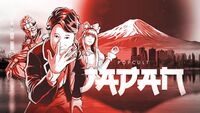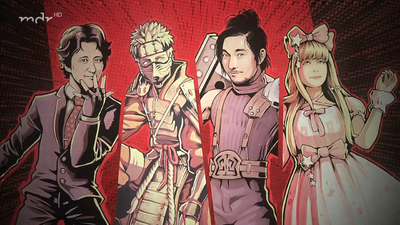Popcult Japan (June 2022)
Mainichi Shimbun (May 2022)
Interview Archive

An interview with Hirohiko Araki from the documentary Popcult Japan by German public TV channel MDR Fernsehen. The video was posted on June 2, 2022 and aired on June 16, 2022.[1][2] The documentary mainly focused on the popularity of anime and manga cosplay in Germany, but also featured a segment where Cathy Cat—a popular Japanese cosplayer and TV presenter born in Germany—interviews Araki from his recluse studio in Tokyo.[3]
Interview
Manga and anime are inseparably connected with the cultural living of Japan. The beginnings of the comic art go back to the 8th century. Since WW2 the industry is booming, the selection of stories grows bigger, more and more niches find their place. Soon, there will be nothing that doesn't already exist. Manga for boys, manga for girls, manga for art enthusiasts, for sport fans, even for gourmets. Their artists, called manga artists in Japan, get praised like celebrities. Yet they often live isolated, working behind closed doors on their masterpieces.
A: “In the end, its always about the characters. I think that a good character, who captivates everyone, creates the basis for a great manga. Whether it's a main character or a side character. And then there’s the world in which these characters inhabit. How an author creates this world and if he succeeds in making it unique, essentially determine the quality of their story.”
In a small studio in Tokyo, one such celebrity grants us insight into his work. In 1986, Hirohiko Araki created a series which today is one of the best-selling manga in the world: JoJo’s Bizarre Adventure. So far, 131 volumes have been released in Japan.
C: “Oh my god, it’s really you! What an honor. It’s a pleasure to meet you. My name is 'Cathy Cat'.”
A: “Hello, the pleasure is all mine.”
C: “So this is Sensei's workplace?”
A: “Yes, this is my office. I usually work over here.”
C: “So this is where you work on your stories?”
A: “Yes that's correct, this is the only spot where I work at. Over there are my assistants and a few other things.”
C: “Oh, and these are your drawings.”
A: “Yes, go ahead, take a look at them!”
C: “Wow, I’m thrilled.”
A: “I’m currently working on my newest piece. Of course, I can’t say anything about the contents.”
The story begins with the bitter feud between Jonathan Joestar and Dio Brando. The spiteful Dio managed to get a hold of a mysterious mask, which bestows him with supernatural powers. Araki's manga is brutal, over the top, and above all else entertaining
A: “I wanted to create a Shonen manga, in other words a manga for boys, that's story was themed around horror. The typical Shonen at that time were Dragon Ball, City Hunter and Fist of the North Star. There were lots of different themes to choose from, There were lots of different themes to choose from. So if I wanted to publish a soccer manga, even if I liked it, I wouldn't be able to because it already existed. The publisher would say "no." So I had to choose a theme that wasn’t taken at the time. And since I was a fan of horror movies, I made a horror story. Unfortunately, they then later told me that I can’t write a horror story for a Shonen manga. I ended up doing it anyways.”
Shortly after, JoJo’s Bizarre Adventure gets published in Shonen Jump magazine. One of the major magazines in which Shonen manga series get published weekly. Almost every big manga originated here. For Araki, 20 years old at the time, this is the final confirmation for his talent. Since his youth, he aspired to be a pro, sending in his first manuscript as a student to the publishers.
A: “I was supposed to study for school, so I drew in secret and hid my drawings under my school books. Unlike today, many parents were under the impression that reading too much manga would rot your brain; and if you listened to rock music as well, you’d end up becoming a criminal sooner or later. To my parents, being a manga artist wasn't a real profession. So I kept working in secret, hoping they would accept it once I made it big.”
However, the life of a manga artist isn’t always as glamorous as it appears. Merciless deadlines, massive stress, and extreme work hours; in an industry that requires creativity on the production line. JoJo’s Bizarre Adventure turns into a hit, even beyond the borders of Japan. 120 million copies have been sold until now. The artwork, enduring generations, has even made it into the Louvre. In 2012, the series received an elaborate anime adaptation, making Araki especially popular abroad.
A: “The aura of a good piece of artwork can be felt at first glance. Even if a Japanese person looks at a painting from Europe, they'll still be moved by it. The same applies to Japanese paintings. People from anywhere on Earth can understand it. It's universal. I think this is the beauty of drawing manga.”
A: "Am Ende geht es immer um die Figuren. Ich denke, ein guter Charakter, der alle in seinen Bann zieht, ist die Grundvoraussetzung für einen guten Manga. Ob das jetzt eine Haupt- oder eine Nebenfigur ist. Und dann ist da noch die Welt, in der sich diese Charaktere bewegen. Wie ein Autor diese Welt gestaltet und ob es ihm gelingt, sie einzigartig zu machen. Das entscheidet maßgeblich über die Qualität seiner Geschichte."
In einem kleinen Tokioter Atelier gewährt uns einer dieser Superstars Einblick in seine Arbeit. 1986 startet Hirohiko Araki eine Serie, die heute zu den meistverkauften Mangas der Welt gehört: "Jojo's Bizarre Adventure". Bisher sind in Japan 131 Bände erschienen.
C: "Wow, Sie sind es wirklich. Was für eine Ehre. Ich freue mich Sie kennenzulernen, mein Name ist Cathy Cat."
A: "Guten Tag, die Freude ist ganz auf meiner Seite."
C: "Also das ist der Arbeitsplatz vom Meister?"
A: "Ja, das ist mein Büro. Ich arbeite hauptsächlich hier drüben."
C: "Hier arbeiten Sie an Ihren Geschichten?"
A: "Genau, dies ist der einzige Platz, an dem ich arbeite. Dort drüben sind meine Assistenten und einige andere Sachen."
C: "Oh, und da sind ja auch Zeichnungen."
A: "Werfen Sie ruhig einen Blick darauf!"
C: "Wow, ich bin begeistert."
A: "Ich arbeite gerade an meiner neusten Idee. Über den Inhalt darf ich natürlich nichts verraten."
Die Geschichte beginnt mit der erbitterten Fehde zwischen Jonathan Joestar und Dio Brando. Der hasserfüllte Dio kam in den Besitz einer geheimnisvollen Maske, die ihm übernatürliche Kräfte verleiht. Arakis Manga ist brutal, überdreht und unglaublich unterhaltsam.
A: "Ich wollte einen Shonen Manga machen, einen Manga für Jungs, der eine Horrorgeschichte als Thema hat. Die typischen Jungs-Manga zu dieser Zeit hießen 'Dragonball', 'City Hunter' oder 'Fist Of The North Star'. Die Themen waren sehr breit gefächert, aber vieles war schon besetzt. Wenn ich z.B. einen Fußball-Manga veröffentlichen wollte, weil ich das sehr mochte, konnte ich das nicht, weil es das schon gab. Der Verlag sagt: nein. Ich musste mir ein Thema aussuchen, das damals noch nicht besetzt war. Und da ich ein Fan von Horrorfilmen war, wurde es eine Horrorgeschichte. Blöd nur, dass man mir dann sagte, dass man für Jungs gar keine Horrorgeschichten schreiben darf. Ich habe es dann trotzdem gemacht."
Kurz darauf wird "Jojo's Bizarre Adventure" erstmals in der "Shonen Jump" veröffentlicht. In einem der großen Magazine, in denen Manga-Serien wochenweise gedruckt werden. So ziemlich jeder große Manga findet hier seinen Anfang. Für Araki, damals Ende 20, die endgültige Bestätigung seines Talents. Seit seiner Jugend wünscht er sich Profi zu werden, schickt seine ersten Zeichnungen noch als Schüler an die Verlage.
A: "Ich sollte eigentlich für die Schule lernen, also zeichnete ich heimlich, versteckte meine Zeichnungen unter den Schulbüchern. Im Gegensatz zu heute waren viele Eltern der Meinung, dass das Lesen zu vieler Mangas dumm mache. Und hörte man dann auch noch Rockmusik, würde man früher oder später sowieso zum Straftäter. Manga-Zeichner war für meine Eltern kein Beruf. Daher arbeitete ich weiter im Verborgenen und hoffte, dass sie es akzeptieren würden, wenn mir der Durchbruch gelänge."
Dabei ist das Leben als Manga artist oft alles andere als glamourös. Gnadenlose Deadlines, massiver Druck, extreme Arbeitszeiten in einer Industrie, die Kreativität am Fließband fordert. "Jojo's Bizarre Adventure" wird zum Erfolg auch über die Grenzen Japans hinaus. 120 Mio. Ausgaben wurden bislang verkauft. Das Werk, mittlerweile ganze Generationen überdauernd, schafft es sogar bis in den Louvre. 2012 bekommt die Serie eine aufwendige Anime-Adaption, die Araki vor allem im Ausland populärer macht.
A: "Die Kraft eines guten Bildes lässt sich auf den 1. Blick erfassen. Wenn sich ein Japaner z.B. ein Gemälde aus Europa anschaut, ist er davon ergriffen. Dasselbe gilt für japanische Bilder. Menschen auf der ganzen Welt können sie verstehen. Sie sind universell.
Gallery
Videos
References
- ↑ https://www.facebook.com/353810578375396/videos/306370468374040
- ↑ https://www.ardmediathek.de/video/mdr-dok/popcult-japan/mdr-fernsehen/Y3JpZDovL21kci5kZS9iZWl0cmFnL2Ntcy83NzhjNTg2Yi05M2Q2LTQzNTYtOWE4OS0yN2RmZDEwYWVlZTc
- ↑ https://www.cathy-cat.com/bio/
- ↑ https://jojo-news.com/2022/06/06/popcult-japan-interview-with-hirohiko-araki-in-germany/

